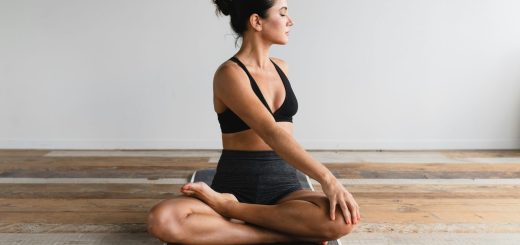How Yoga Works: Understanding the Science Behind the Practice

Before diving in, please note: This post is for informational purposes only. If you’d like to know more about how we approach topics, feel free to check out our friendly Disclaimer Page.
Hey there, amazing readers! 🖐️ Just a quick note: yes, we know there are a lot of ads here. Trust us, we get it—it’s not the prettiest look, but they help us keep this blog alive and kicking. Those pesky little ads cover the costs of all the behind-the-scenes magic, from hosting and tech stuff to creating content we hope you’ll love.
We’re committed to delivering quality posts, and your support (even just sticking around despite the ads) means everything to us. So, bear with us, and thanks for helping us keep the good vibes rolling. Now, on to the fun stuff! 😉
TRANSLATE BUTTON AT THE END OF THE ARTICLE
A Quick Overview
Yoga has become a buzzword in today’s fast-paced world, but what does it really entail?
The essence of yoga transcends mere physical postures; it’s about harmonizing the mind, body, and spirit.
As someone who has practiced yoga for years, I can tell you that its benefits are profound and multifaceted.
This article offers a deep dive into the science behind yoga, exploring everything from its ancient roots to the ways it can enhance our mental and physical health.
So, grab your mat, and let’s get started!
What is Yoga? An Introduction to the Ancient Practice
Yoga originated in ancient India over 5,000 years ago.
It’s a spiritual and philosophical practice with roots in Hinduism and Buddhism.
The word "yoga" comes from the Sanskrit word "yuj," which means to unite or join.
The practice aims to unify the body, mind, and spirit.
The different styles of yoga—Hatha, Vinyasa, Ashtanga, Kundalini—each bring something unique to the table.
I remember my first yoga class, where I assumed it was all about stretching and bending.
But as I learned more, I discovered that yoga is also a path to self-discovery and mindfulness.
Yoga incorporates physical poses (asanas), breathing techniques (pranayama), and meditation (dhyana).
This trifecta works together to promote overall well-being.
As practitioners, we come to realize that yoga is not just a workout; it’s a way of life.
While various styles exist, the overarching goal remains the same: to increase self-awareness and promote relaxation.
Each practice can offer something special.
For instance, Hatha yoga often focuses on alignment, while Vinyasa can be more dynamic and fluid, almost like a dance.
In today’s world, where stress and anxiety are commonplace, yoga serves as a refuge.
It encourages us to slow down and be present.
Doesn’t that sound delightful?
The Mind-Body Connection: A Yoga Perspective
Let’s ponder this: Have you ever noticed how your mood can shift depending on your physical state?
Yoga taps into this mind-body connection in remarkable ways.
Scientific research supports the idea that our mental and emotional states can affect our physical health.
Conversely, our physical health impacts our emotions.
During my yoga practice, I often feel my worries melt away as I focus on my breath and movement.
This connection allows for a deeper understanding of our feelings.
The mind-body relationship is not just philosophical; it’s backed by studies showing how yoga can influence stress levels and overall mood.
One fascinating aspect is how yoga enhances our ability to manage stress.
When we engage in yoga, we stimulate the parasympathetic nervous system.
This is our body’s natural relaxation response.
It’s like switching from a sprint to a gentle stroll.
Through regular practice, we also cultivate mindfulness, which helps us become more aware of our thoughts and feelings.
Instead of getting swept away by emotions, we learn to observe them without judgment.
Many practitioners report that yoga helps them cope with life’s challenges, whether it’s dealing with a tough workday or navigating personal relationships.
This increased resilience can lead to a healthier, happier life.
Anatomy of Yoga: How Poses Affect Our Bodies
When we step onto our mats, we engage in a dance of anatomy.
Every pose affects different muscle groups, joints, and organs.
For instance, downward dog stretches the spine and strengthens the shoulders, while a warrior pose opens the hips and builds leg strength.
Understanding how yoga affects our bodies can enhance our practice.
I’ve learned that when I focus on alignment and proper technique, I not only avoid injury but also maximize the benefits of each pose.
Poses like the bridge or cobra can open up the chest, promoting better lung function and breathing.
Ever felt a rush of energy after a good stretch?
That’s your body waking up, releasing pent-up tension.
Yoga also encourages blood circulation, which is vital for delivering oxygen and nutrients throughout the body.
With improved circulation, we feel more energized and less fatigued.
Moreover, certain poses stimulate the endocrine system, helping regulate hormones.
This is crucial for managing stress and emotional well-being.
The beauty of yoga lies in its adaptability.
Each pose can be modified to suit individual capabilities.
Whether it’s easing into a gentle practice or challenging ourselves with advanced postures, yoga is inclusive.
Breathing Techniques: Unlocking Prana Energy Flow
Breath is the essence of life, and in yoga, it’s considered the bridge between the mind and body.
The term "pranayama" refers to breath control and is fundamental in yoga practice.
It’s not just about inhaling and exhaling; it’s about harnessing our life force energy.
I remember the first time I focused solely on my breath during practice.
It was transformative!
By paying attention to my inhalations and exhalations, I found a deeper sense of calm.
Pranayama techniques help regulate our energy levels.
For instance, deep, slow breaths can calm the mind, while quick, shallow breaths can invigorate and energize.
It’s all about tuning into what your body needs at that moment.
Different breathing exercises target various outcomes:
Nadi Shodhana (Alternate Nostril Breathing): Balances the left and right sides of the brain, promoting clarity and calm.
Ujjayi (Victorious Breath): Creates internal heat and focuses the mind, often used during asana practice.
Kapalabhati (Skull-Shining Breath): Energizes the body and cleanses the lungs, great for a quick pick-me-up.
By integrating pranayama into our routine, we cultivate mindfulness and awareness.
It becomes a tool for grounding ourselves, especially on chaotic days.
The Role of Flexibility: Why Stretching Matters
Flexibility is often the first thing that comes to mind when we think about yoga.
But why is it so important?
Flexibility enhances our range of motion, which can reduce the risk of injury.
Our bodies are meant to move, and flexibility allows us to do that freely and fluidly.
In my own practice, I’ve found that improving flexibility has made everyday activities easier.
Simple tasks like bending to tie my shoes or reaching for something on a high shelf have become less challenging.
Moreover, flexibility supports joint health.
When we stretch our muscles, we promote better blood circulation.
This can help alleviate tension and stiffness in the joints.
It’s crucial to approach flexibility with patience.
Some days, I feel like a pretzel; other days, I struggle to touch my toes.
That’s okay!
Each practice is an opportunity to listen to my body.
Additionally, increased flexibility can lead to better posture.
Many of us spend hours hunched over our screens.
Yoga encourages alignment, helping us stand tall and reduce strain on our backs.
So, let’s embrace flexibility not as a goal but as a journey.
Celebrate small victories along the way, and you might be surprised at how much more limber you feel over time!
Building Strength Through Yoga: More Than Just Stretching
When we think about strength, we often picture heavy weights or intense workouts.
However, yoga offers a different path to building strength.
Many poses require us to support our body weight in various ways, engaging multiple muscle groups simultaneously.
Take the plank pose, for instance.
While it seems simple, it challenges the core, arms, and legs.
I’ve found that practicing yoga has improved my overall strength and stability.
Strength gained from yoga is functional.
It helps us in daily activities, like lifting groceries or playing with kids.
Unlike traditional weight training, yoga builds endurance and resilience, too.
Moreover, many poses promote balance.
The tree pose, for example, requires concentration and stability.
As we improve our balance, we also enhance our body awareness.
Yoga helps us cultivate inner strength.
It teaches us to push through discomfort—both physically and mentally.
That ability to remain calm and composed during challenging situations translates to life off the mat.
In short, yoga empowers us to build strength from the inside out.
It’s not limited to physical prowess; it’s about developing mental fortitude as well.
The Science of Relaxation: Stress Relief in Yoga
In a world filled with deadlines and responsibilities, stress relief is vital.
Yoga shines as a beacon of hope in our hectic lives.
Studies have shown that regular yoga practice can reduce cortisol levels, the hormone associated with stress.
When we practice yoga, we engage in a variety of techniques that promote relaxation.
Deep breathing, mindful movement, and meditation work collectively to calm the nervous system.
I’ve often left a yoga class feeling lighter and more at peace.
Research indicates that just a few minutes of yoga can significantly decrease anxiety and tension.
It’s as if we’re hitting a reset button on our minds.
Moreover, yoga promotes better sleep.
Many practitioners report improved sleep quality and duration after incorporating yoga into their routines.
Who wouldn’t want that?
I remember a time when I struggled to wind down at night.
After starting a bedtime yoga routine, I found it easier to drift off into dreamland.
In essence, yoga teaches us valuable relaxation techniques we can access anytime.
Whether it’s a few minutes of mindful breathing in the middle of a busy day or a dedicated evening practice, the benefits are tangible.
Yoga and Mental Health: Benefits for the Mind
Yoga’s impact on mental health is profound.
Numerous studies point to its ability to alleviate symptoms of anxiety and depression.
Through the combination of movement, breath, and mindfulness, yoga offers a holistic approach to mental well-being.
In my experience, yoga helps me manage my thoughts.
When I’m on the mat, my worries often fade.
The act of focusing on my breath and body provides a much-needed mental break.
Research shows that yoga can increase serotonin levels, the “feel-good” hormone.
This chemical is essential for regulating mood and emotions.
Furthermore, engaging in a community yoga class can foster a sense of belonging.
Sharing space with others who are also seeking peace creates supportive energy.
It’s like a collective hug!
For those grappling with trauma, yoga offers a safe space for healing.
Trauma-sensitive yoga encourages gentle movement and breath, allowing individuals to reconnect with their bodies.
Ultimately, yoga teaches us to cultivate self-compassion.
It helps us create a nurturing relationship with our minds, leading to greater resilience and emotional strength.
Neuroscience Meets Yoga: Brain Benefits Explained
Let’s nerd out for a moment!
The intersection between neuroscience and yoga is fascinating.
Research reveals that regular yoga practice can actually alter brain structure and function.
It’s not just feel-good fluff; there’s science behind it!
Mindfulness practices, including yoga, have been linked to increased gray matter in areas of the brain associated with memory, emotional regulation, and self-awareness.
How cool is that?
Studies suggest that yoga may enhance cognitive function as well.
Improved concentration, memory retention, and even creativity can stem from consistent practice.
I’ve often noticed that after a yoga session, my focus sharpens, making it easier to tackle tasks at hand.
Moreover, yoga has been shown to reduce symptoms of neurodegenerative diseases.
For instance, some studies indicate that yoga can help improve balance and coordination in individuals with Parkinson’s disease.
The practice also promotes neuroplasticity—the brain’s ability to rewire itself.
This means that through yoga, we can create new neural pathways, enhancing our mental agility and overall brain health.
So, not only does yoga benefit our bodies, but it also nourishes our minds.
It’s a win-win!
The Importance of Mindfulness in Yoga Practice
Mindfulness is at the core of yoga.
It encourages us to be present, fostering a deeper connection with ourselves and our surroundings.
When I first encountered mindfulness in yoga, it felt like a revelation.
I had been so caught up in my thoughts that I often missed the beauty of the moment.
In yoga, mindfulness invites us to observe our thoughts without judgment.
It teaches us to focus on our breath and movements, allowing distractions to fade into the background.
This practice can spill over into our daily lives, making us more aware and present in our interactions.
Mindfulness can also enhance our resilience.
When faced with challenges, we learn to respond rather than react—a powerful skill in today’s chaotic world.
Additionally, practicing mindfulness in yoga helps us cultivate gratitude.
As we move through poses, we become more aware of our bodies and what they can do.
This appreciation fosters a sense of contentment.
For anyone feeling overwhelmed, mindfulness in yoga serves as a gentle reminder to slow down.
It’s perfectly okay to take a moment, breathe, and simply be.
Yoga’s Impact on Physical Health: A Scientific Look
Yoga isn’t just a feel-good practice; it’s backed by scientific research that highlights its numerous health benefits.
Regular practice can lead to improved cardiovascular health, enhanced flexibility, and even weight management.
Studies have shown that yoga can lower blood pressure and improve heart rate variability.
This is crucial for reducing the risk of heart disease.
I’ve seen friends who incorporate yoga into their routines report lower cholesterol levels and better overall health.
Moreover, yoga aids in digestion.
Poses like seated twists stimulate the digestive organs, promoting better gut health.
Who doesn’t want a happy belly?
Research also points to improvements in chronic pain conditions.
Many individuals suffering from lower back pain, arthritis, or headaches find relief through yoga.
The gentle stretching and strengthening can alleviate discomfort.
In summary, the physical health benefits of yoga are vast.
It empowers us to take control of our bodies, providing tools for better health and longevity.
Getting Started: Tips for Your Yoga Journey Ahead
So, you’re ready to embark on your yoga journey?
Fantastic!
Here are some tips to get you started:
Find Your Style: Experiment with different styles to see what resonates with you.
From gentle Hatha to dynamic Vinyasa, there’s something for everyone.
Listen to Your Body: Yoga is about connecting with yourself.
If a pose doesn’t feel right, modify or skip it.
Your practice is your own.
Practice Regularly: Consistency is key.
Even short sessions can provide benefits.
Aim for a few minutes daily to cultivate a habit.
Join a Class: If you can, take a class with an experienced instructor.
They can provide guidance on alignment and technique.
Invest in a Good Mat: A non-slip yoga mat makes a significant difference in your practice.
It provides stability and comfort.
Wear Comfortable Clothing: Choose breathable, flexible clothing that allows for movement.
You want to feel free, not restricted.
Incorporate Breathwork: Don’t neglect pranayama!
Focusing on your breath can deepen your practice and enhance relaxation.
Be Patient: Progress takes time.
Celebrate your small wins, whether it’s mastering a pose or simply feeling more relaxed.
Have Fun: Enjoy the process!
Yoga is a journey, not a destination.
Let it be playful and lighthearted.
Stay Open-Minded: Yoga can surprise you.
Keep an open heart, and you may discover benefits you never expected.
Conclusion
Yoga is a beautiful practice that offers a wealth of benefits for both the body and mind.
It connects us to ourselves, fostering a sense of community and well-being.
Whether you’re looking to reduce stress, enhance flexibility, or build strength, yoga has something to offer you.
As I reflect on my personal journey with yoga, I realize it has transformed my life in ways I never anticipated.
It’s not just about the poses; it’s about embracing the journey, the breath, and the connection to oneself.
So, if you’re contemplating stepping onto your mat, I wholeheartedly encourage you to do so.
Your body and mind will thank you!

The Enlightenment Journey is a remarkable collection of writings authored by a distinguished group of experts in the fields of spirituality, new age, and esoteric knowledge.
This anthology features a diverse assembly of well-experienced authors who bring their profound insights and credible perspectives to the forefront.
Each contributor possesses a wealth of knowledge and wisdom, making them authorities in their respective domains.
Together, they offer readers a transformative journey into the realms of spiritual growth, self-discovery, and esoteric enlightenment.
The Enlightenment Journey is a testament to the collective expertise of these luminaries, providing readers with a rich tapestry of ideas and information to illuminate their spiritual path.
Our Diverse Expertise 🌟
While our primary focus is on spirituality and esotericism, we are equally passionate about exploring a wide range of other topics and niches 🌍📚. Our experienced team is dedicated to delivering high-quality, informative content across various subjects ✨.
To ensure we provide the most accurate and valuable insights, we collaborate with trusted experts in their respective domains 🧑🏫👩🏫. This allows us to offer well-rounded perspectives and knowledge to our readers.
Our blog originally focused on spirituality and metaphysics, but we’ve since expanded to cover a wide range of niches. Don’t worry—we continue to publish a lot of articles on spirituality! Frequently visit our blog to explore our diverse content and stay tuned for more insightful reads.





